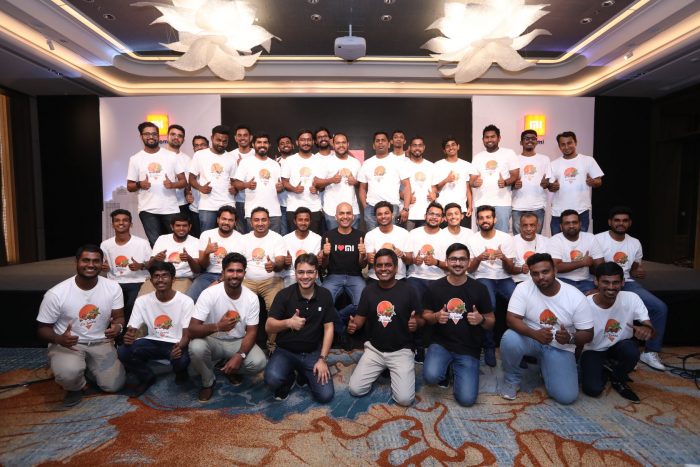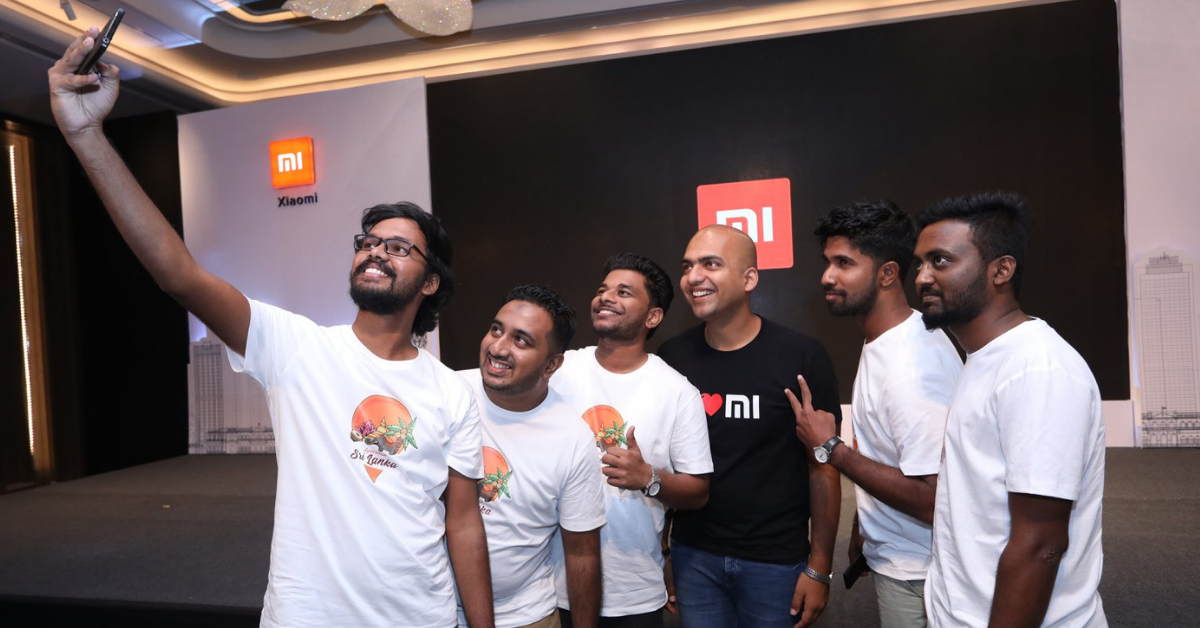If you’re a fan of phones like we are then you’re definitely familiar with the name Xiaomi. The Chinese electronics company offers a wide range of products from cameras to smart home systems to air purifiers. But what it’s famous for even in Sri Lanka are its line of smartphones. These phones have gained a reputation for offering great value for money with flagship specs at affordable prices.

Thus, it’s not surprising that as of Q2 of 2018, the company became the 4th largest smartphone manufacturer in the world. Furthermore, it’s a leader in China and India, both of which are the largest smartphone markets in the world. Now Xiaomi has entered the Sri Lankan market with its latest mid-range and flagship phones.
The phones Xiaomi is selling in Sri Lanka
It should be noted that Xiaomi phones have been available in Sri Lanka for a while now. With its famous reputation, many third-party resellers have made sure to stock Xiaomi phones. But with its official arrival in Sri Lanka, the company has officially introduced 7 phones to the market on their website. Here’s the full list.
The Pocophone F1
The first of these is the most famous Xiaomi phone to date: The Pocophone F1. Ever since this phone was announced it’s had many enthusiasts confused. This was a phone that offered flagship specs at a surprisingly affordable price. It was later that we found that the secret to this was that Xiaomi had streamlined production and didn’t have to invest heavily in R&D.

The Pocophone F1 will be available in Sri Lanka for Rs. 59,999. So what exactly does it offer for that price? You get a phone with a 6.18-inch FHD+ screen. Inside you’ll find a powerful Snapdragon 845 Octa-core processor that uses liquid cooling. It’s powered by a 4000mAh battery that supports fast charging. It also features a 12MP + 5MP dual rear camera along with a 20MP front camera.
Finally, it’ll be running MIUI 10, which is Xiaomi’s version of Android 8.1 Oreo. Currently, the only version available for Sri Lanka is the model with 64GB of storage and 6GB of RAM. This storage can be expanded with a micro SD card up to 256 GB.
The four Redmi phones
Alongside the Pocophone F1, Xiaomi also introduced 4 phones in its Redmi line-up to Sri Lanka. Among these, the high-end model is the Redmi Note 6 Pro. Its main feature seems to be the dual front and rear cameras. On the rear, the Redmi Note 6 Pro features a 12MP + 5MP dual camera. On the front, it features a 20MP + 2MP camera.
The Redmi Note 6 Pro is available in Sri Lanka in two versions. The first comes with 32GB of storage and 3GB of RAM at Rs. 35,999. The second version comes with 64GB of storage and 4GB of RAM at Rs. 39,999. Both phones feature a 4000mAh battery that supports fast charging.
Meanwhile, on the budget end of this line-up, you’ll find the Redmi 6A. It features a single 13MP rear camera and a 5MP front camera. Inside you’ll find a 2.0 GHz Quad-core processor and a 3000 mAh battery. Along with a 5.45 inch 720p screen, the Redmi 6A ships with MIUI 9.0, which is based on Android 8.1 Oreo. The Redmi 6A is available in Sri Lanka at Rs. 17,999 with 16GB of storage and 2GB of RAM.

In between, you have the Redmi 6 & the Redmi S2. The Xiaomi Redmi 6 comes with an Octa-core 2.0 GHz processor and a 3000 mAh battery. It also features a 5.45-inch 720p screen. Finally, it too packs a 12MP + 5MP rear camera, which is its main feature, along with a 5MP front camera. The Redmi 6 is priced at Rs. 24,999 and comes with 32GB storage and 3GB of RAM.

Then there’s the Redmi S2. It packs a Snapdragon 625 octa-core processor and a 3080 mAh battery. Alongside a 5.9-inch screen, it too like the other phones packs a 12MP + 5MP rear camera. On the front, you’ll find a single 16MP rear camera on the Redmi S2. The Redmi S2 comes in two versions. The first is priced at Rs. 28,999 and features 32GB of storage with 3GB of RAM. The second is priced at Rs. 34,999 and features 64GB of storage with 4GB of RAM.
The two Mi phones
Finally, we have the Xiaomi Mi A2 and Mi A2 Lite. The Mi A2’s main feature is its 20MP + 12MP dual-camera rear camera. It also comes with a 20MP front camera. Inside this phone, you’ll find a Snapdragon 660 octa-core processor with a 3000 mAh battery. The Mi A2 currently available in Sri Lanka features 4GB of RAM with 64GB of storage and is priced at Rs. 45,999.

Meanwhile, the Mi A2 lite features the standard 12MP + 5MP dual rear camera. Along with a 5.8-inch screen, it packs a 5MP front camera. Inside is a Snapdragon 625 processor with a 4000 mAh battery. The Mi A2 Lite comes in two versions. One features 32GB of storage with 3GB of RAM at Rs. 30,999. The second features 64GB of storage with 4GB of RAM at Rs. 35,999. Interestingly, both phones come with the Android One version of Android 8.1 Oreo and can be upgraded to the latest Android 9.0 Pie.
So why is Xiaomi interested in Sri Lanka?
Manu Jain – Vice President, Xiaomi & Managing Director, Xiaomi India said, “Is Sri Lanka as big as India, China, or Indonesia? Of course not. It’s a much smaller market. But we believe it’s an important market for us for multiple reasons.” The first of these reasons he cited was that he believes internet access is increasing.
1) Make devices cheaper and money off the internet
High internet penetration is essential for Xiaomi, which doesn’t consider devices to be its main source of revenue. Manu explained this saying, “Our job starts when we sell the phone because we have to think about all the internet services we offer you.” He elaborated on this with examples of their partnerships with Ola and Swiggy, which are some of the unicorns operating in India.

To that end, the company works towards making its devices accessible. Manu elaborated on this stating that the cost of components reduces over time. Therefore, Xiaomi reduced the price of their phones by INR. 1000 in India. Another way he shared that the company looks at reducing costs is by streamlining distribution to reduce the number of middlemen involved.
Additionally, Xiaomi announced earlier this year that it would cap its hardware profit margin at 5% indefinitely. While shocking to many, analysts have stated this is manageable for most smartphone manufacturers. Yet, Manu added that this decision and along with others has allowed Xiaomi to offer its devices at what he describes as an honest price.

This honest price he went onto define as offering high-quality devices at affordable devices. Speaking on the quality of Xiaomi devices, Manu said, “It doesn’t make sense for us to put a Snapdragon 845 and compromise on some small component. All our phones go through multiple tests. We are fanatical about quality.”
2) Sri Lanka and its GDP per capita
The second reason Manu cited for Xiaomi entering the local market was the average per capita GDP of Sri Lanka was one of the best in the Indian subcontinent. As of 2017, Sri Lanka had a GDP per capita of $4,065.22. For comparison, the GDP per capita of some countries in the region at that same time is as follows: $1,939.61 for India, $835.08 for Nepal, $1516.51 for Bangladesh, $10,535.79 for the Maldives, and $1547.85 for Pakistan.
Based on this, we can see that while Sri Lanka isn’t the highest its GDP per capita is above average. However, it should be noted that the recent trade war between China & the US and the exchange rate crisis could have affected these numbers. Nonetheless, Xiaomi has a positive outlook on the Sri Lankan market.
Jain went on to elaborate on this saying, “If people are more prosperous, they’re willing to spend more money. So will this market be as big as India or China? Of course not because the population is much smaller. But we believe it’s still an important strategic market for us.” This is why he shared that over time, they will look at ensuring Xiaomi’s latest phones enter the Sri Lankan market only a few weeks after they’re first announced.
So what does Xiaomi’s arrival mean for Sri Lanka?
More competition is always welcome. For consumers, more competition in the smartphone industry means getting better quality devices at more affordable prices. With Xiaomi entering the local market, it’s very likely this could happen. Its most expensive flagship Pocophone F1 being priced at approximately Rs. 60,000 is a far cry from the other flagships priced at Rs. 100,000.

As such, one could argue in the local mid-range smartphone market, Xiaomi will be a heavy contender. Currently, this market is dominated by the likes of Huawei, Samsung, and Oppo. Among these local players, we constantly see Huawei releasing a plethora of mid-range phones on a regular basis here in Sri Lanka. These launches follow heavy marketing campaigns.
Additionally, one cannot ignore the strong reputation Xiaomi already has. A reputation for offering phones with great specifications and great value for money. To be precise, phones with strong specs at mid-range prices. Of course, one should also remember that Xiaomi has clearly stated that it aims to earn its money from services over devices.

Yet, with internet penetration at only 30%, Sri Lanka is still yet to reach the stage where you can order a masseuse or a mechanic through an app. Nonetheless, it’s a growing market. As such, we’ll likely see Xiaomi localize its online services and form partnerships to meet the needs of the Sri Lankan market. Ultimately, while the future is unpredictable, we’re in for some interesting times with Xiaomi’s entrance.






GIPHY App Key not set. Please check settings